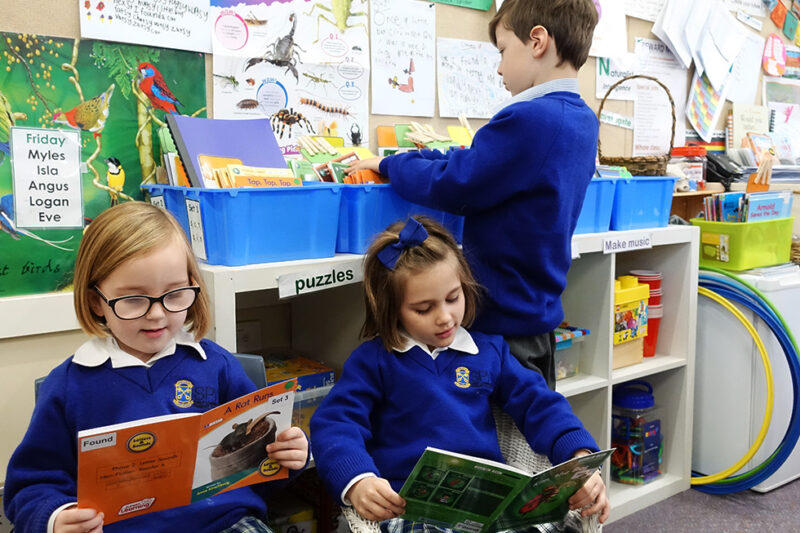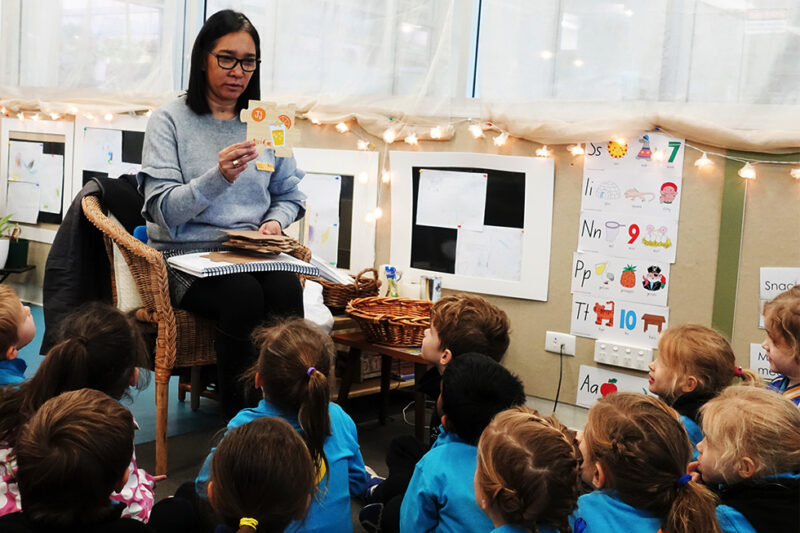With literacy a top priority at SPW, we’ve recently implemented a new Reading and Spelling program, and are tracking children’s progress and development from our Early Learning Centre through to Year 7.
It’s exciting to report, we’re seeing early evidence of success from across the school as a result of the implementation of the new Reading and Spelling program called Letters and Sounds.
Establishing Fundamental Skills in the Early Years
The Foundation (Reception) to Year 2 classes have been using the Letter’s and Sounds Framework. The framework has a strong emphasis on developing student’s phonic knowledge through a systematic, synthetic phonics approach. The engagement of our students in this program has been excellent. We’re quickly seeing the positive effects of the explicit classroom teaching, paired with the support of parents following up with home activities. This is setting our students up with strong decoding skills to enable them to attack large numbers of unknown words.
Our teachers are enjoying the structure this program offers. They’ve expressed their delight in seeing children actually reading instead of looking at the first sound in a word, or looking at the pictures and guessing.
“All the children are genuinely reading – not guessing! The kids feel empowered and confident. I have seen the greatest whole class achievement since I began teaching this program.”
Reception teacher.
We’re also seeing students use blending and segmenting skills as reversible processes and increased accuracy when spelling. This is giving children the ability to write and spell independently. How wonderful to be setting our students up with the foundation skills and strategies used by strong readers and spellers.
Resourcing for success
SPW values the role of research in setting up our Reading and Spelling program. The research indicates decodable readers are essential to match teaching happening in classrooms. SPW has purchased and embedded use of decodable readers into the classroom which has been of huge benefit to our beginning readers. It gives opportunities to apply the sounds they’re learning and practise their blending skills to decode the text at home. Ultimately strengthening the partnership between home and school with their reading development.
“Students feel much more confident as they’re able to independently decode the readers. Parents have commented that their child is happily engaged at home, independently reading these new readers.”
Year 1 Teacher
Working with parents
Beneficial to the success of our Reading and Spelling program is the partnership between home and school. It’s been wonderful to have so many parents attend reading workshops and be so enthusiastic about supporting their child’s reading development. We’re excited to share our knowledge on what research and evidence says is best practice. Feedback from parents around the new Reading and Spelling program has been overwhelmingly positive.
“After learning more about the new program at the workshop, this approach to learning how to read just makes sense.”
SPW Parent
Supporting children at all stages of development
Not only does this program benefit our early readers, it also supports students with underlying learning difficulties. Helping students who may need to revisit different sounds, or those who need additional practise with blending and segmenting of words. Importantly, this program covers the five areas of reading which include phonological awareness, phonics, vocabulary, fluency and comprehension. Our approach ensures students get daily instruction and practise in all of these areas.
Literacy Framework from Early Learning through to Year 7
Our Early Learning Centre also embeds the Reading and Spelling program in the curriculum, developing student’s skills in phonological and phonemic awareness from an early age. The early development of these skills is critical to future success in reading and spelling. We value highly the role our early educators play in providing, both formal and informal, teaching opportunities for our 2 to 4 year old children.
A structured approach to spelling
Once our students move into Year 3 the focus turns to spelling. The scope and sequence used follows a structured literacy approach. It’s systematic and cumulative. Building on prior knowledge, the program provides opportunity for sounds to be revisited if not yet concrete. Our teachers enjoy having a structure to align their teaching to, as well as explicitly delving deeper into the structure of the English language.
Within our program children have been exploring:
- Phonology and using phoneme/grapheme mapping to spell regular words.
- Syllable types and how they help in understanding the role of the vowel and and the sound it makes within syllables.
- Morphology and how prefixes and suffixes are units of meaning that change the base word.
- Etymology of words – word origins, whether from the Greek, Latin or French, and the meaning they bring to English words.
Early signs of success
It’s exciting to see students investigating different layers of spelling and start to apply this to their own use of language, adding to their vocabularies.
“The Students enjoyed displaying their understanding of open and closed syllable types by creating learning resources to help them remember the rules.”
Year 4 teacher
As we celebrate early signs of success, we’re pleased with observations and feedback from our middle and upper primary students, as we continue to consolidate their spelling knowledge.
“Using multi-sensory techniques, such as the interactive whiteboard to click and drag words or cutting and sticking syllables to connect words together, has helped different kinds of learners connect with the task. We’ve also used the whiteboard tables and markers for students to experiment with different letter combinations before committing to a spelling.”
Year 4 Teacher
We look forward to tracking the progress of our Literacy programs for students here at SPW, from Early Learning through to Year 7. Developing and adopting this program has meant all teachers, across the school, have a common language and approach. This development is brilliant for our staff. The real winners though, as you can imagine, are our children.
To learn more about the Literacy program at SPW, please contact Learning Support Teacher, Jo Hirst or Head of Learning and Teaching, Amanda Kelly. Parents can access further resources about the Letters and Sounds Framework from their website.